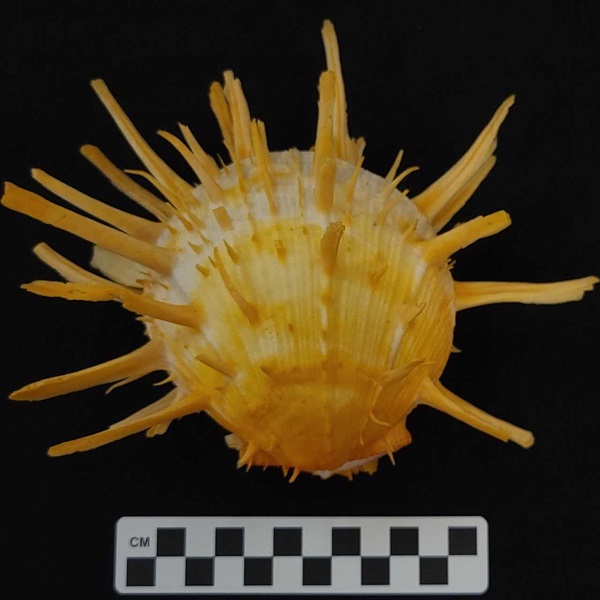What is so great about a Mollusk shell having spines or spikes? We could say they are pretty and even spectacular, and that would be true. However, they actually have a very specific purpose in the life of mollusks.
Let us imagine we are a Clam (Bivalve). We do not have hands or tentacles that could be used to hold on to things around us such as rocks or coral growths. Now let us suppose we lived in shallow habitats under the surface of our sandy or muddy environment, knowing that there are always tides and currents that could rip us out of our snug home.
What would aid in remaining where we are safe and healthy? The growth of spines or spikes on our outer shell would give us an anchor to remain in place and stay buried in our habitat. One good example of this type of modification to the shell is the Pitar lupanaria from the west coasts of Mexico through Peru.

Is it possible for these fragile shells to be moved about by waves and currents without breaking these spines? It is possible for such spines to remain unbroken, and some species bearing spines or spikes can repair or regrow them. These mollusks have adapted spines that are actually hollow, allowing parts of the living animal to lay down new growth of calcium carbonate to repair and regrow these structures. A beautiful example of a species capable of such repairs is the delicate Murex pectin, (aka “The Venus Comb Murex”) from much of the South Pacific such as the Philippine Islands and as far as Madagascar.

Sailors of old would occasionally find these shells washed up on rocks or beaches and they believed the shells were used by Mermaids to comb their long hair. Thus, the name “Venus Comb”, has been handed down to us and is still commonly used to refer to this species.
The Family MURICIDAE is one of the largest Family of mollusks. Many species in this Family produce spines, frilly webbing or stout spikes such as the Hexaplex fulvescens, (aka “The Giant Eastern Murex”) which lives along Texas’ beaches and from South Carolina to Florida.

The MURICIDAE, (commonly called Murex) are predators in their habitats and move about searching for their prey using their large, muscular foot much as the snails in your garden move. So why do you think these predators capable of moving around would need to develop such appendages as spines or spikes? In the ocean there are always larger predators looking for a meal. Since Murex are capable of moving around to search for their prey they can be seen more easily by other predators. For protection, such sharp, hard projections provide great armor against such attackers.
Now, the list of reasons for developing spines or spikes includes:
- Anchorage in habitats.
- Armor against predators.
What other reasons could have caused some mollusks to develop such spiny or spikey extensions to their calcium carbonate shells? Camouflage is an important part of the lives of many prey species. One great examples of this adaptation is found in the Family of bivalves called Spondylus (aka “Thorney Oysters”); which are not oysters at all since they are members of the Super Family of PECTINIDAE (Scallops).
How can these spines be used to provide camouflage? While providing armor against predators, these extensions of the shell also provide homes for sponges, algae and other organisms to attach and grow thus hiding the animal in its shell almost completely. One example found locally along the Texas coast to Florida that uses these spines to provide camouflage is Spondylus americanus.


These beautiful mollusks live permanently attached to rocks, pilings, Oil Rig supports and even sunken boats. Since they live their whole lives in one place and are visible to passing, hungry fish; Camouflage is most valuable to survival. Now the list of uses includes Camouflage from predators.
Another commonly asked question is “Do these mollusks use their spikes or spines to pry open the shells of their intended meal”? Yes, some have developed a specialized, single tooth-like projection that is capable of assisting in opening the shells of their prey. In the Family FASCIOLARIDAE there is a striking example that uses its single, long spike for this purpose.

Opeatostoma pseudodon, known as the “Banded Tooth Latirus”, illustrates the sharp spike used by this species to help open the shells of bivalves or other prey items such as barnacles. Other Families of mollusks as well make use of such adaptations and they serve much the same purpose.
As widely varied as the previous reasons are, another valuable reason for producing spines is to aid in reproduction. This is perhaps most easily seen in the Genus Lambis of the Family Strombidae. These mollusks produce long or short spines along the outer edge of their shells and can vary between the male and female of certain species. These spines may be used by the male to move the female into position to accomplish the production of the next generations of their species.

As you visit the George W. Strake Hall of Malacology, see how many of these spectacular shells produced by mollusks you can find. In each case, imagine the uses for the lovely, delicate or strong spines and spikes visible on the shells. Nature is remarkable in its millions of adaptations for success in our amazing Natural World.
Want more from Curator of Malacology Tina Petway?
From our Collections: You Should See Me in a Crown – The Queen Conch
From the Curator: The Purple Sea Snail – Upside Down Wanderer






